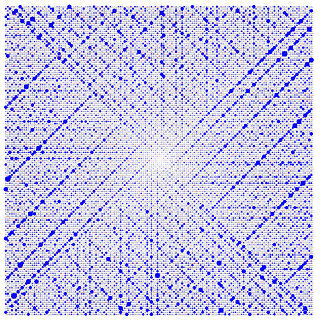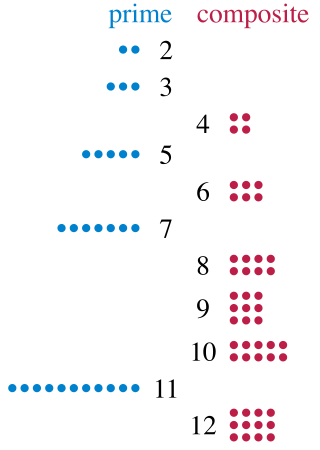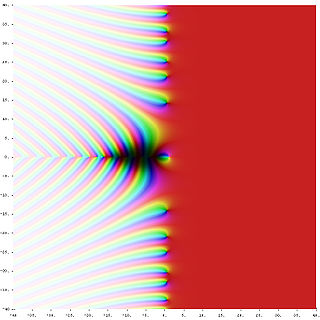
Number theory is a branch of pure mathematics devoted primarily to the study of the integers and arithmetic functions. German mathematician Carl Friedrich Gauss (1777–1855) said, "Mathematics is the queen of the sciences—and number theory is the queen of mathematics." Number theorists study prime numbers as well as the properties of mathematical objects constructed from integers, or defined as generalizations of the integers.

A prime number is a natural number greater than 1 that is not a product of two smaller natural numbers. A natural number greater than 1 that is not prime is called a composite number. For example, 5 is prime because the only ways of writing it as a product, 1 × 5 or 5 × 1, involve 5 itself. However, 4 is composite because it is a product (2 × 2) in which both numbers are smaller than 4. Primes are central in number theory because of the fundamental theorem of arithmetic: every natural number greater than 1 is either a prime itself or can be factorized as a product of primes that is unique up to their order.
In mathematics, the prime number theorem (PNT) describes the asymptotic distribution of the prime numbers among the positive integers. It formalizes the intuitive idea that primes become less common as they become larger by precisely quantifying the rate at which this occurs. The theorem was proved independently by Jacques Hadamard and Charles Jean de la Vallée Poussin in 1896 using ideas introduced by Bernhard Riemann.
In number theory, Dirichlet's theorem, also called the Dirichlet prime number theorem, states that for any two positive coprime integers a and d, there are infinitely many primes of the form a + nd, where n is also a positive integer. In other words, there are infinitely many primes that are congruent to a modulo d. The numbers of the form a + nd form an arithmetic progression
The Riemann hypothesis is one of the most important conjectures in mathematics. It is a statement about the zeros of the Riemann zeta function. Various geometrical and arithmetical objects can be described by so-called global L-functions, which are formally similar to the Riemann zeta-function. One can then ask the same question about the zeros of these L-functions, yielding various generalizations of the Riemann hypothesis. Many mathematicians believe these generalizations of the Riemann hypothesis to be true. The only cases of these conjectures which have been proven occur in the algebraic function field case.
In mathematics, the Dirichlet convolution is a binary operation defined for arithmetic functions; it is important in number theory. It was developed by Peter Gustav Lejeune Dirichlet.
Linnik's theorem in analytic number theory answers a natural question after Dirichlet's theorem on arithmetic progressions. It asserts that there exist positive c and L such that, if we denote p(a,d) the least prime in the arithmetic progression

In mathematics, analytic number theory is a branch of number theory that uses methods from mathematical analysis to solve problems about the integers. It is often said to have begun with Peter Gustav Lejeune Dirichlet's 1837 introduction of Dirichlet L-functions to give the first proof of Dirichlet's theorem on arithmetic progressions. It is well known for its results on prime numbers and additive number theory.
Vorlesungen über Zahlentheorie is the name of several different textbooks of number theory. The best known was written by Peter Gustav Lejeune Dirichlet and Richard Dedekind, and published in 1863. Others were written by Leopold Kronecker, Edmund Landau, and Helmut Hasse. They all cover elementary number theory, Dirichlet's theorem, quadratic fields and forms, and sometimes more advanced topics.
In mathematics, more specifically in the field of analytic number theory, a Landau–Siegel zero or simply Siegel zero, named after Edmund Landau and Carl Ludwig Siegel, is a type of potential counterexample to the generalized Riemann hypothesis, on the zeros of Dirichlet L-functions associated to quadratic number fields. Roughly speaking, these are possible zeros very near to .
In algebraic number theory, the prime ideal theorem is the number field generalization of the prime number theorem. It provides an asymptotic formula for counting the number of prime ideals of a number field K, with norm at most X.
Additive number theory is the subfield of number theory concerning the study of subsets of integers and their behavior under addition. More abstractly, the field of additive number theory includes the study of abelian groups and commutative semigroups with an operation of addition. Additive number theory has close ties to combinatorial number theory and the geometry of numbers. Two principal objects of study are the sumset of two subsets A and B of elements from an abelian group G,
In mathematics, arithmetic combinatorics is a field in the intersection of number theory, combinatorics, ergodic theory and harmonic analysis.
Hans-Egon Richert was a German mathematician who worked primarily in analytic number theory. He is the author of a definitive book on sieve theory.
In number theory, the parity problem refers to a limitation in sieve theory that prevents sieves from giving good estimates in many kinds of prime-counting problems. The problem was identified and named by Atle Selberg in 1949. Beginning around 1996, John Friedlander and Henryk Iwaniec developed some parity-sensitive sieves that make the parity problem less of an obstacle.
A timeline of number theory.

Anatoly Alexeyevich Karatsuba was a Russian mathematician working in the field of analytic number theory, p-adic numbers and Dirichlet series.
This is a glossary of concepts and results in number theory, a field of mathematics. Concepts and results in arithmetic geometry and diophantine geometry can be found in Glossary of arithmetic and diophantine geometry.